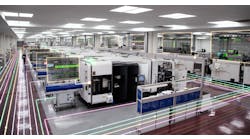Renowned engine builder, Carl Wegner, partners with Columbia Marking Tools to provide a system to peen/scribe and laser mark 2D/UID Matrix codes on engine components.
When Wisconsin-based Wegner Motorsports (www.wegnerautomotive2.com) introduced the new Grand National ”Spec” engine in the NASCAR booth at the Performance Racing Industry (PRI) Show in Orlando, Florida, in December 2005, Columbia Marking Tools, Inc. (www.columbiaamt.com) said it didn’t know that its presence as an exhibitor would land it the opportunity to work with one of racings renowned engine builders.
NASCAR introduced Wegner’s new “Spec” engine in 2005 for teams in the NASCAR Grand National Division that includes the AutoZone Series and Busch East Series.
The new engine includes a specified set of precision parts and components that are designed for performance and durability, at a reduced cost. NASCAR has made a concerted effort to reduce the cost of racing in the Grand National Division, and the “Spec” engine package costs approximately half the price of most traditional custom-built engines.
Dan Timm, general manager of Wegner Motorsports, said when he was at the Performance Racing Industry show he saw the Columbia Marking Tools booth and wandered in to explore the types and level of marking technology that could provide the information and data that his shop needed to put on its engine components.
“With the new “Spec” engine, we not only needed a mark that would provide information with respect to program prefixes and sequential part numbering, we also needed a system that could instantly validate the part and also have the ability to remotely read the mark for the purpose of insuring authenticity and providing useful part history,” Timm said.
“We found that Columbia’s newlypatented 2D/UID Square Dot 2D Matrix code marking system had the programmability and the versatility to provide the marking technology that was needed for our cast, machined and heat treated components.”
“The types of components we are marking include; crankshafts, connecting rods, pistons, blocks, cylinder heads, intake and exhaust manifolds, fuel pumps, and valves as well as a variety of other pulleys and brackets. We also needed to have the ability to mark hardened 4140 steel parts that had been either nitrided or tuff-nitrided,” Timm said.
Square Dot Marking Machine
The machine that Wegner Motorsports put into production is Columbia’s 3-in-1 machine that is an extension of its standard Columbia DPS (Dot-Peen-Scribe) programmable marking machine. The 3-in-1 machine has added laser marking capability.
Wegner selected both peen/scribe and laser marking for the 2D Square Dot marks so it has the ability to mark hardened or heat treated parts.
The basic design of the machine uses an X-Y-Z slide arrangement that is driven through precise linear ballscrews. The ballscrews are bellows-protected.
The standard machine is allelectric and has its peen and laser marking head modules mounted to its slide assembly by two removable bolts. The company said the machine has a high-performance stepper motor drive that gives 0.02-mm repeatability at 5 characters per second, or for Wegner Motorsports, a 2D Square Dot mark in 3 seconds.
The scribe marking head has an extended tool life, multi-faceted diamond etch stylus for making the 2D mark quietly. The marking force is electrically actuated.
The laser-marking unit uses a compact, low-cost 50-W adjustable diode laser with variable power from 0 W to 50 W. The laser module requires less than five minutes to retrofit to the Columbia DPS unit.
With the Z-axis, automatic pin-to-part distance control can be accommodated, and switching from peen/scribe marking to laser is performed by flipping a switch on the machine control.
Wegner Motorsports purchased a model DPS150 machine that has a 4 in. by 6-in. (100 mm by 150mm) marking window.
The shop also added an optional rotator attachment that adds the ability to mark the periphery of round parts. The rotator unit can be mounted directly to the T-slots of the marking machine table and is equipped with an 80-mm (3.15 in.) chuck that is driven by an industrial stepper motor. The chuck for the machine can be as large as 150 mm (5.9 in.). Columbia marking machine PC software controls the integration of the rotator axis.
The Columbia DPS marking system is available with a Columbia PCS 2000 controller that features a 15-in LCD monitor and a touch screen keyboard that eliminates the need for a commercial plug in keyboard.
The PCS 2000 is preloaded with Windows XP Professional operating system that has user-friendly prompts for quick navigation through programming.
Additional Columbia 2D and human-readable UID/ Square Dot and Cognex Vision software also is preloaded.
In addition, pcAnywhere software is provided, to allow Columbia Marking Tools to connect directly to the PCS-2000 control via the Internet from the service office at Columbia Marking Tools for fast and secure troubleshooting, programming assistance, software upgrades, and even making adjustments to the cameras used on UID/ Square Dot scribe marking machines. This remote management feature allows the user to directly access vital operating system utilities.
“For Wegner Motorsports, the programmable DPS marking unit was incorporated into a stand-alone full floor welded machine table/ base construction,” Andy Habedank, Columbia application engineering manager said.
The machine is equipped with an optional positioning arm that allows the marking unit to be rotated 360- degrees for marking very large parts from the opposite side of the table base, and a Cognex 2D vision system was integrated into the machine design to provide the required marking verification, Habedank added. The system includes an In- Sight Cognex 5100 vision camera with a 25-mm lens and ambient light filter, vision processor and lighting power regulator. Wegner Motorsports also purchased six hand-held Cognex readers so parts can be verified right at the race track.
Dan Timm said he was amazed that the machine required no special shrouding for its camera, and that it required only simple LED lighting so that it could read the mark. That includes recognizing the machinereadable 2D codes. “One other point: We had the marking machine up and running, marking parts within four hours of unloading it off the truck,” Timm added.
Patented Square Dot Marking
The Square Dot refers to the patented process by which Columbia’s DPS marking systems make the 2D Matrix code mark.
When they are scribing or laser marking a 2D Matrix code, the marking heads displace material in a manner that leaves a specifically recessed area of grooves and ridges formed by displaced material that, to the eye or a camera, look like round dot-like indentations.
These grooves and ridges form a very reflective multifaceted data cell that has high contrast between grooves and the unscribed or laser marked surface that enable a vision system to clearly and accurately distinguish where the grooves are, even in the presence of extraneous interfering marks or deposits.
By interfacing the highly-accurate movement of the scribe head and X and Y axes with CNC control, 2D Matrix codes can be marked at very high speed with Grade “A” readability, the highest standard rating, equivalent to 1,200 reads per second with no variations.
| CAM previews at Eastec Several Computer-Aided Machining (CAM) software developers, including include Gibbs and Associates (www.gibbscam.com), Delcam Plc. (www.delcam.com), and Planit Solutions, the producer of the EdgeCAM software package (www.planitsolutions.com), are planning to introduce new software at the annual Eastec trade show May 20 through May 22 in West Springfield, Mass. |






